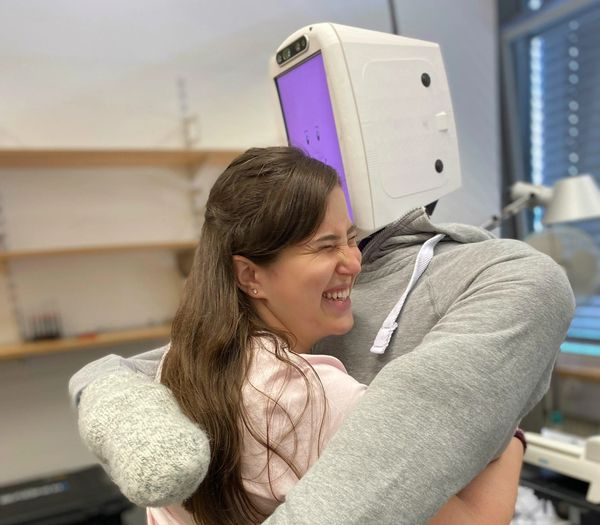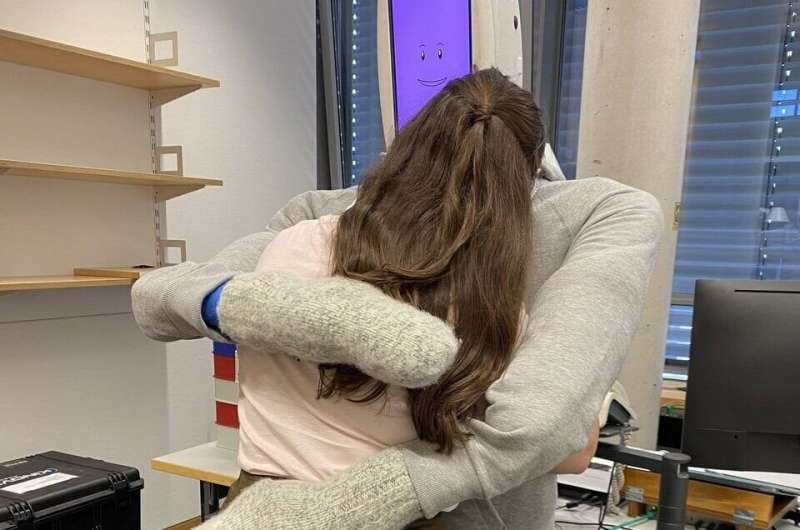|
HuggieBot 3.0 is the third iteration of a robot
designed by a team at the Max Planck Institute for Intelligent Systems
to deliver the perfect hug.
Hugging probably isn’t the first thing that comes to mind when thinking
about things that robots could help humankind with, but a team of
scientists at the Max Planck Institute for Intelligent Systems
disagrees. Alexis E. Block and her colleagues have been involved in the
HuggieBot project for years, trying to create a robot that could deliver
human-like hugs and thus replace actual people in various scenarios like
providing comfort to the lonely, or replacing someone who just can’t
deliver a hug in person for some reason. Their third iteration, the
HuggieBot 3.0, is apparently quite the hugger…
|
|
 |
|
The creators of HuggieBot 3.0 claim that it is “the first fully
autonomous human-sized hugging robot that recognizes and responds to the
user’s intra-hug gestures”. It features a custom sensing system called
‘HuggieChest’ which incorporates two inflated chambers of polyvinyl
chloride to imitate a soft chest. But there’s a lot more than a soft
chest to the HuggieBot 3.0.
The advanced robot delivers hugs using a pair of Kinova JACO arms
mounted to a custom metal frame that were selected for being
anthropomorphic, quiet, and safe. As a hug takes place, a barometric
pressure sensor and microphone inside the artificial chest detect human
touch and begin transmitting data via an Arduino Mega microcontroller
board to a Robot Operating System (ROS)-based computer located in the
HuggieBot 3.0’s 3D-printed head.
|
|
 |
|
The team used feedback from 512 real people over 32 trials to train a
machine learning system capable of detecting and classifying a range of
gestures performed during a hug and responding appropriately. The
HuggieBot 3.0 can stay still, move slightly vertically, tap or pat a
person’s back and squeeze with varying degrees of pressure.
Rather than maximizing user acceptance for each robot gesture, which
would result in the robot only squeezing the user, our behavior
algorithm balances exploration and exploitation to create a natural,
spontaneous robot that provides comforting hugs,” the team behind
HuggieBot 3.0 wrote in a recent study.
|
 |
|
Alexis E. Block started working on the original HuggieBot back in 2016
while studying for a Master’s degree in robotics. The first iteration
was built on six “hugging commandments”, such as the need for the robot
to be soft and warm, and to autonomously enter into and end an embrace.
The HuggieBit 2.0 took the project a step further by incorporating
haptic perception to deliver adaptive hugging, but the 3.0 iteration is
the most advanced version yet, with five added hugging commandments
designed to deliver a human-like hugging experience.
In a recent test on 16 participants who had also tried previous versions
of the HuggieBot, 12 participants who hugged the robot for longer
declared that they felt significantly more understood by the machine and
that it was “significantly nicer to hug” than previous iterations.
The HuggieBot 3.0 isn’t perfect, and its creators point out that it
isn’t quite like hugging a real person just yet, but they are already
working on a fourth version that should come with improved hug
positioning and techniques. They hope that one day HuggieBot will be
able to replicate the sensation of human hugging to perfection.
|